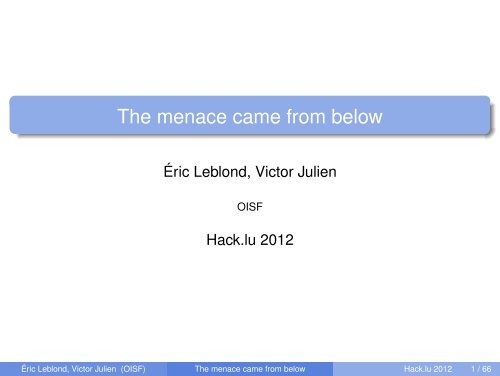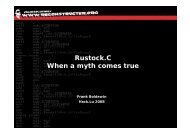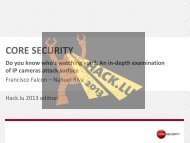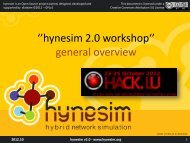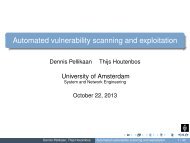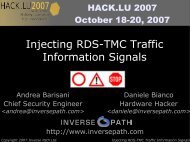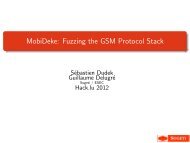Create successful ePaper yourself
Turn your PDF publications into a flip-book with our unique Google optimized e-Paper software.
<strong>The</strong> <strong>menace</strong> <strong>came</strong> <strong>from</strong> <strong>below</strong><br />
Éric Leblond, Victor Julien<br />
OISF<br />
<strong>Hack</strong>.<strong>lu</strong> 2012<br />
Éric Leblond, Victor Julien (OISF) <strong>The</strong> <strong>menace</strong> <strong>came</strong> <strong>from</strong> <strong>below</strong> <strong>Hack</strong>.<strong>lu</strong> 2012 1 / 66
Eric Leblond a.k.a Regit<br />
French<br />
Network security expert<br />
Free Software enthousiast<br />
NuFW project creator (Now ufwi), EdenWall co-founder<br />
Netfilter developer:<br />
Ulogd2: Netfilter logging daemon<br />
Misc contributions:<br />
NFQUEUE library and associates<br />
Source NAT randomisation (defeat Kaminsky’s DNS attack)<br />
Currently:<br />
Independant security consultant<br />
Suricata IDS/IPS funded developer<br />
Éric Leblond, Victor Julien (OISF) <strong>The</strong> <strong>menace</strong> <strong>came</strong> <strong>from</strong> <strong>below</strong> <strong>Hack</strong>.<strong>lu</strong> 2012 2 / 66
Victor Julien a.k.a Inliniac<br />
Dutch<br />
Open Source Developer and Contractor<br />
Vuurmuur Firewall project creator<br />
Suricata IDS/IPS lead developer<br />
Éric Leblond, Victor Julien (OISF) <strong>The</strong> <strong>menace</strong> <strong>came</strong> <strong>from</strong> <strong>below</strong> <strong>Hack</strong>.<strong>lu</strong> 2012 3 / 66
What is Suricata<br />
IDS and IPS engine<br />
Get it here:<br />
http://www.suricata-ids.org<br />
Open Source (GPLv2)<br />
Funded by US government and<br />
consortium members<br />
Run by Open Information Security<br />
Foundation (OISF)<br />
More information about OISF at<br />
http://www.<br />
openinfosecfoundation.org/<br />
Éric Leblond, Victor Julien (OISF) <strong>The</strong> <strong>menace</strong> <strong>came</strong> <strong>from</strong> <strong>below</strong> <strong>Hack</strong>.<strong>lu</strong> 2012 4 / 66
Suricata Features<br />
High performance, scalable through multi threading<br />
Protocol identification<br />
File identification, extraction, on the fly MD5 calculation<br />
TLS handshake analysis, detect/prevent things like Diginotar<br />
Hardware acceleration support:<br />
Endace<br />
Napatech,<br />
CUDA<br />
PF_RING<br />
Éric Leblond, Victor Julien (OISF) <strong>The</strong> <strong>menace</strong> <strong>came</strong> <strong>from</strong> <strong>below</strong> <strong>Hack</strong>.<strong>lu</strong> 2012 5 / 66
Suricata Features<br />
Rules and outputs compatible to Snort syntax<br />
useful logging like HTTP request log, TLS certificate log<br />
(experimental) Lua scripting for detection<br />
Éric Leblond, Victor Julien (OISF) <strong>The</strong> <strong>menace</strong> <strong>came</strong> <strong>from</strong> <strong>below</strong> <strong>Hack</strong>.<strong>lu</strong> 2012 6 / 66
1 Introduction<br />
Netfilter and the Conntrack<br />
Degree of freedom in Netfilter helpers<br />
2 Multi-layer attack<br />
Conditions and principles<br />
FTP case<br />
Checkpoint<br />
Others protocols<br />
3 Impact and existing protection<br />
Netfilter<br />
Detecting the attack<br />
4 Protocol analysis attack<br />
Protocol analysis<br />
Low TTL attack<br />
<strong>The</strong> attack on nDPI and Suricata<br />
5 Conc<strong>lu</strong>sion<br />
Éric Leblond, Victor Julien (OISF) <strong>The</strong> <strong>menace</strong> <strong>came</strong> <strong>from</strong> <strong>below</strong> <strong>Hack</strong>.<strong>lu</strong> 2012 7 / 66
Netfilter<br />
Definition<br />
Packet filtering framework inside the Linux 2.4.x to 3.x kernel series.<br />
Éric Leblond, Victor Julien (OISF) <strong>The</strong> <strong>menace</strong> <strong>came</strong> <strong>from</strong> <strong>below</strong> <strong>Hack</strong>.<strong>lu</strong> 2012 8 / 66
Netfilter<br />
Definition<br />
Packet filtering framework inside the Linux 2.4.x to 3.x kernel series.<br />
Features<br />
Stateful and stateless packet filtering (IPv4 and IPv6).<br />
Network address and port translation (NAT).<br />
Multiple layers of API’s for 3rd party extensions.<br />
Éric Leblond, Victor Julien (OISF) <strong>The</strong> <strong>menace</strong> <strong>came</strong> <strong>from</strong> <strong>below</strong> <strong>Hack</strong>.<strong>lu</strong> 2012 8 / 66
Netfilter<br />
Definition<br />
Packet filtering framework inside the Linux 2.4.x to 3.x kernel series.<br />
Features<br />
Iptables<br />
Stateful and stateless packet filtering (IPv4 and IPv6).<br />
Network address and port translation (NAT).<br />
Multiple layers of API’s for 3rd party extensions.<br />
Command line utility to do operation on rules.<br />
It has access to all Netfilter features.<br />
Two utilities: iptables for IPv4, ip6tables for IPv6.<br />
i p t a b l e s −A FORWARD −p tcp −−syn −−dport 80 \<br />
−m c o n n l i m i t −−c o n n l i m i t −above 2 −j REJECT<br />
Éric Leblond, Victor Julien (OISF) <strong>The</strong> <strong>menace</strong> <strong>came</strong> <strong>from</strong> <strong>below</strong> <strong>Hack</strong>.<strong>lu</strong> 2012 8 / 66
Application Level Gateway<br />
Non-linear protocol<br />
One can find protocols such as FTP or SIP:<br />
<strong>The</strong>y rely on a signalling channel.<br />
It is used to setup dynamic connections.<br />
Éric Leblond, Victor Julien (OISF) <strong>The</strong> <strong>menace</strong> <strong>came</strong> <strong>from</strong> <strong>below</strong> <strong>Hack</strong>.<strong>lu</strong> 2012 9 / 66
Application Level Gateway<br />
Non-linear protocol<br />
One can find protocols such as FTP or SIP:<br />
<strong>The</strong>y rely on a signalling channel.<br />
It is used to setup dynamic connections.<br />
Application Level Gateway (ALG)<br />
ALGs search the traffic for command messages.<br />
<strong>The</strong>y extract information on the expected connections.<br />
Each expectation:<br />
inc<strong>lu</strong>des information on a potential connection.<br />
is associated to a timeout.<br />
New connection matching an expectation can be accepted.<br />
Éric Leblond, Victor Julien (OISF) <strong>The</strong> <strong>menace</strong> <strong>came</strong> <strong>from</strong> <strong>below</strong> <strong>Hack</strong>.<strong>lu</strong> 2012 9 / 66
<strong>The</strong> example of FTP<br />
FTP client<br />
Logged i n to f t p . l i p 6 . f r .<br />
n c f t p / > l s<br />
etc / j u s s i e u / l i p 6 /<br />
Tcpdump<br />
195.83.118.1.21 > 10.62.101.203.52994<br />
195.83.118.1.21 > 10.62.101.203.52994<br />
10.62.101.203.57636 > 195.83.118.1.51155<br />
10.62.101.203.52994 > 195.83.118.1.21<br />
195.83.118.1.51155 > 10.62.101.203.57636<br />
Éric Leblond, Victor Julien (OISF) <strong>The</strong> <strong>menace</strong> <strong>came</strong> <strong>from</strong> <strong>below</strong> <strong>Hack</strong>.<strong>lu</strong> 2012 10 / 66
<strong>The</strong> example of FTP<br />
FTP client<br />
Logged i n to f t p . l i p 6 . f r .<br />
n c f t p / > l s<br />
etc / j u s s i e u / l i p 6 /<br />
Protocol<br />
Tcpdump<br />
195.83.118.1.21 > 10.62.101.203.52994<br />
195.83.118.1.21 > 10.62.101.203.52994<br />
10.62.101.203.57636 > 195.83.118.1.51155<br />
10.62.101.203.52994 > 195.83.118.1.21<br />
195.83.118.1.51155 > 10.62.101.203.57636<br />
C: PASV<br />
S: 227 Entering Passive Mode (195,83,118,1,199,211)<br />
C: MLSD<br />
S: 150 Opening ASCII mode data connection for ’MLSD’.<br />
S: 226 MLSD complete.<br />
C: QUIT<br />
Éric Leblond, Victor Julien (OISF) <strong>The</strong> <strong>menace</strong> <strong>came</strong> <strong>from</strong> <strong>below</strong> <strong>Hack</strong>.<strong>lu</strong> 2012 10 / 66
<strong>The</strong> example of FTP<br />
FTP client<br />
Logged i n to f t p . l i p 6 . f r .<br />
n c f t p / > l s<br />
etc / j u s s i e u / l i p 6 /<br />
Protocol<br />
Tcpdump<br />
195.83.118.1.21 > 10.62.101.203.52994<br />
195.83.118.1.21 > 10.62.101.203.52994<br />
10.62.101.203.57636 > 195.83.118.1.51155<br />
10.62.101.203.52994 > 195.83.118.1.21<br />
195.83.118.1.51155 > 10.62.101.203.57636<br />
C: PASV<br />
S: 227 Entering Passive Mode (195,83,118,1,199,211)<br />
C: MLSD<br />
S: 150 Opening ASCII mode data connection for ’MLSD’.<br />
S: 226 MLSD complete.<br />
C: QUIT<br />
Netfilter<br />
# conntrack −E expect<br />
[NEW] 300 proto =6 src =10.62.101.203 dst =195.83.118.1 s p o r t =0 dport =51155<br />
[DESTROY] 300 proto =6 src =10.62.101.203 dst =195.83.118.1 s p o r t =0 dport =51155<br />
Éric Leblond, Victor Julien (OISF) <strong>The</strong> <strong>menace</strong> <strong>came</strong> <strong>from</strong> <strong>below</strong> <strong>Hack</strong>.<strong>lu</strong> 2012 10 / 66
Details of Netfilter implementation<br />
ALGs in Netfilter<br />
ALGs are called Helpers.<br />
Each protocol is implemented as a kernel module.<br />
Loading options can be used to configure the helper.<br />
Fine-grained setup can be achieved with the CT iptables target.<br />
Éric Leblond, Victor Julien (OISF) <strong>The</strong> <strong>menace</strong> <strong>came</strong> <strong>from</strong> <strong>below</strong> <strong>Hack</strong>.<strong>lu</strong> 2012 11 / 66
Details of Netfilter implementation<br />
ALGs in Netfilter<br />
ALGs are called Helpers.<br />
Each protocol is implemented as a kernel module.<br />
Loading options can be used to configure the helper.<br />
Fine-grained setup can be achieved with the CT iptables target.<br />
Current modules list in Vanilla linux kernel<br />
amanda pptp broadcast proto_dccp<br />
ftp proto_gre h323 proto_sctp<br />
proto_udplite sane irc sip<br />
netbios_ns snmp tftp<br />
Éric Leblond, Victor Julien (OISF) <strong>The</strong> <strong>menace</strong> <strong>came</strong> <strong>from</strong> <strong>below</strong> <strong>Hack</strong>.<strong>lu</strong> 2012 11 / 66
Do I use helpers?<br />
What happens if I load a helper?<br />
Éric Leblond, Victor Julien (OISF) <strong>The</strong> <strong>menace</strong> <strong>came</strong> <strong>from</strong> <strong>below</strong> <strong>Hack</strong>.<strong>lu</strong> 2012 12 / 66
Do I use helpers?<br />
What happens if I load a helper?<br />
Can a user send crafted messages and go freely through the<br />
firewall?<br />
Éric Leblond, Victor Julien (OISF) <strong>The</strong> <strong>menace</strong> <strong>came</strong> <strong>from</strong> <strong>below</strong> <strong>Hack</strong>.<strong>lu</strong> 2012 12 / 66
Do I use helpers?<br />
What happens if I load a helper?<br />
Can a user send crafted messages and go freely through the<br />
firewall?<br />
Do helpers transform my firewall in openbar?<br />
Éric Leblond, Victor Julien (OISF) <strong>The</strong> <strong>menace</strong> <strong>came</strong> <strong>from</strong> <strong>below</strong> <strong>Hack</strong>.<strong>lu</strong> 2012 12 / 66
Do I use helpers?<br />
What happens if I load a helper?<br />
Can a user send crafted messages and go freely through the<br />
firewall?<br />
Do helpers transform my firewall in openbar?<br />
Éric Leblond, Victor Julien (OISF) <strong>The</strong> <strong>menace</strong> <strong>came</strong> <strong>from</strong> <strong>below</strong> <strong>Hack</strong>.<strong>lu</strong> 2012 12 / 66
Do I use helpers?<br />
What happens if I load a helper?<br />
Can a user send crafted messages and go freely through the<br />
firewall?<br />
Do helpers transform my firewall in openbar?<br />
A study is needed.<br />
Let’s look at the helpers.<br />
Éric Leblond, Victor Julien (OISF) <strong>The</strong> <strong>menace</strong> <strong>came</strong> <strong>from</strong> <strong>below</strong> <strong>Hack</strong>.<strong>lu</strong> 2012 12 / 66
Global analysis<br />
Sane defaults<br />
Dangerous extensions of protocols have been disabled.<br />
If we study the attack of client on a server:<br />
It is impossible to open arbitrary connections to the server.<br />
<strong>The</strong> level of security is acceptable.<br />
Éric Leblond, Victor Julien (OISF) <strong>The</strong> <strong>menace</strong> <strong>came</strong> <strong>from</strong> <strong>below</strong> <strong>Hack</strong>.<strong>lu</strong> 2012 13 / 66
Global analysis<br />
Sane defaults<br />
Dangerous extensions of protocols have been disabled.<br />
If we study the attack of client on a server:<br />
It is impossible to open arbitrary connections to the server.<br />
<strong>The</strong> level of security is acceptable.<br />
In the limit of protocols<br />
Security is ensured with regard to the protocol usability.<br />
IRC helper is really user-friendly.<br />
Éric Leblond, Victor Julien (OISF) <strong>The</strong> <strong>menace</strong> <strong>came</strong> <strong>from</strong> <strong>below</strong> <strong>Hack</strong>.<strong>lu</strong> 2012 13 / 66
FTP analysis<br />
If we follow RFC (loose = 0).<br />
A FTP server can participate to the initialization of a connection<br />
<strong>from</strong> client to another server.<br />
It can open arbitrary connections through the firewall.<br />
Éric Leblond, Victor Julien (OISF) <strong>The</strong> <strong>menace</strong> <strong>came</strong> <strong>from</strong> <strong>below</strong> <strong>Hack</strong>.<strong>lu</strong> 2012 14 / 66
FTP analysis<br />
If we follow RFC (loose = 0).<br />
A FTP server can participate to the initialization of a connection<br />
<strong>from</strong> client to another server.<br />
It can open arbitrary connections through the firewall.<br />
If we care about security (loose = 1).<br />
Expectation are statically bound to the server address.<br />
<strong>The</strong> possible openings are acceptable.<br />
This is the default va<strong>lu</strong>e.<br />
Éric Leblond, Victor Julien (OISF) <strong>The</strong> <strong>menace</strong> <strong>came</strong> <strong>from</strong> <strong>below</strong> <strong>Hack</strong>.<strong>lu</strong> 2012 14 / 66
IRC analysis<br />
<strong>The</strong> DCC command<br />
DCC command enables transfer between end-point.<br />
It is impossible to know the source address.<br />
Destination port is fixed by the client.<br />
Éric Leblond, Victor Julien (OISF) <strong>The</strong> <strong>menace</strong> <strong>came</strong> <strong>from</strong> <strong>below</strong> <strong>Hack</strong>.<strong>lu</strong> 2012 15 / 66
IRC analysis<br />
<strong>The</strong> DCC command<br />
DCC command enables transfer between end-point.<br />
It is impossible to know the source address.<br />
Destination port is fixed by the client.<br />
Consequences<br />
Allowing DCC is thus allowing client to enable arbitrary connection<br />
to his IP.<br />
Client computer is given a complete freedom of connection<br />
opening.<br />
Éric Leblond, Victor Julien (OISF) <strong>The</strong> <strong>menace</strong> <strong>came</strong> <strong>from</strong> <strong>below</strong> <strong>Hack</strong>.<strong>lu</strong> 2012 15 / 66
Using DCC command<br />
Client NATed behind firewall, port N is closed<br />
Éric Leblond, Victor Julien (OISF) <strong>The</strong> <strong>menace</strong> <strong>came</strong> <strong>from</strong> <strong>below</strong> <strong>Hack</strong>.<strong>lu</strong> 2012 16 / 66
Using DCC command<br />
Client NATed behind firewall, port N is closed<br />
Client sends a DCC command to a valid IRC server<br />
Éric Leblond, Victor Julien (OISF) <strong>The</strong> <strong>menace</strong> <strong>came</strong> <strong>from</strong> <strong>below</strong> <strong>Hack</strong>.<strong>lu</strong> 2012 16 / 66
Using DCC command<br />
Client NATed behind firewall, port N is closed<br />
Client sends a DCC command to a valid IRC server<br />
Firewall creates expectation and laptop can open a connection<br />
Éric Leblond, Victor Julien (OISF) <strong>The</strong> <strong>menace</strong> <strong>came</strong> <strong>from</strong> <strong>below</strong> <strong>Hack</strong>.<strong>lu</strong> 2012 16 / 66
Demonstration of DCC usage<br />
Video<br />
Éric Leblond, Victor Julien (OISF) <strong>The</strong> <strong>menace</strong> <strong>came</strong> <strong>from</strong> <strong>below</strong> <strong>Hack</strong>.<strong>lu</strong> 2012 17 / 66
Demonstration of DCC usage<br />
Video<br />
Let’s connect <strong>from</strong> Internet to port 6000 of a NATed client.<br />
Éric Leblond, Victor Julien (OISF) <strong>The</strong> <strong>menace</strong> <strong>came</strong> <strong>from</strong> <strong>below</strong> <strong>Hack</strong>.<strong>lu</strong> 2012 17 / 66
1 Introduction<br />
Netfilter and the Conntrack<br />
Degree of freedom in Netfilter helpers<br />
2 Multi-layer attack<br />
Conditions and principles<br />
FTP case<br />
Checkpoint<br />
Others protocols<br />
3 Impact and existing protection<br />
Netfilter<br />
Detecting the attack<br />
4 Protocol analysis attack<br />
Protocol analysis<br />
Low TTL attack<br />
<strong>The</strong> attack on nDPI and Suricata<br />
5 Conc<strong>lu</strong>sion<br />
Éric Leblond, Victor Julien (OISF) <strong>The</strong> <strong>menace</strong> <strong>came</strong> <strong>from</strong> <strong>below</strong> <strong>Hack</strong>.<strong>lu</strong> 2012 18 / 66
Objective<br />
Determine if it is possible as client to trigger unwanted behaviour<br />
Can we open arbitrary pinholes through a firewall?<br />
Can we open more ports on a server?<br />
Can we access to badly protected service ?<br />
Such as an internal database<br />
Such as vulnerable services<br />
Éric Leblond, Victor Julien (OISF) <strong>The</strong> <strong>menace</strong> <strong>came</strong> <strong>from</strong> <strong>below</strong> <strong>Hack</strong>.<strong>lu</strong> 2012 19 / 66
Objective<br />
Determine if it is possible as client to trigger unwanted behaviour<br />
Can we open arbitrary pinholes through a firewall?<br />
Can we open more ports on a server?<br />
Can we access to badly protected service ?<br />
Such as an internal database<br />
Such as vulnerable services<br />
Study of helpers has shown that it is not possible out of the box<br />
Client capabilities are always limited.<br />
Dangerous extensions have been blocked.<br />
An alternative approach should be found.<br />
Éric Leblond, Victor Julien (OISF) <strong>The</strong> <strong>menace</strong> <strong>came</strong> <strong>from</strong> <strong>below</strong> <strong>Hack</strong>.<strong>lu</strong> 2012 19 / 66
Attack description<br />
Existing attacks force server to send command<br />
By forcing it to send error message containing a command<br />
By jumping between helpers<br />
Éric Leblond, Victor Julien (OISF) <strong>The</strong> <strong>menace</strong> <strong>came</strong> <strong>from</strong> <strong>below</strong> <strong>Hack</strong>.<strong>lu</strong> 2012 20 / 66
Attack description<br />
Existing attacks force server to send command<br />
By forcing it to send error message containing a command<br />
By jumping between helpers<br />
"On est jamais mieux servi que par soi-même"<br />
Attacker can simply send crafted packets for the server<br />
If he is on on ethernet network connected to the server<br />
Packet is seen at Ethernet level as coming <strong>from</strong> client<br />
Packet at IP level is coming <strong>from</strong> server and containing a command<br />
Éric Leblond, Victor Julien (OISF) <strong>The</strong> <strong>menace</strong> <strong>came</strong> <strong>from</strong> <strong>below</strong> <strong>Hack</strong>.<strong>lu</strong> 2012 20 / 66
Attack description<br />
Existing attacks force server to send command<br />
By forcing it to send error message containing a command<br />
By jumping between helpers<br />
"On est jamais mieux servi que par soi-même"<br />
Attacker can simply send crafted packets for the server<br />
If he is on on ethernet network connected to the server<br />
Packet is seen at Ethernet level as coming <strong>from</strong> client<br />
Packet at IP level is coming <strong>from</strong> server and containing a command<br />
Man on the side<br />
Attacker is part of the conversation<br />
This is not TCP session hijacking<br />
Packet parameters are build using standard algorithms<br />
Éric Leblond, Victor Julien (OISF) <strong>The</strong> <strong>menace</strong> <strong>came</strong> <strong>from</strong> <strong>below</strong> <strong>Hack</strong>.<strong>lu</strong> 2012 20 / 66
Attack description for FTP<br />
1 <strong>The</strong> attacker sniffs traffic coming <strong>from</strong> a FTP server.<br />
Éric Leblond, Victor Julien (OISF) <strong>The</strong> <strong>menace</strong> <strong>came</strong> <strong>from</strong> <strong>below</strong> <strong>Hack</strong>.<strong>lu</strong> 2012 21 / 66
Attack description for FTP<br />
1 <strong>The</strong> attacker sniffs traffic coming <strong>from</strong> a FTP server.<br />
2 He opens a connection to the FTP server.<br />
Éric Leblond, Victor Julien (OISF) <strong>The</strong> <strong>menace</strong> <strong>came</strong> <strong>from</strong> <strong>below</strong> <strong>Hack</strong>.<strong>lu</strong> 2012 21 / 66
Attack description for FTP<br />
1 <strong>The</strong> attacker sniffs traffic coming <strong>from</strong> a FTP server.<br />
2 He opens a connection to the FTP server.<br />
3 He forges a packet using the last packet received <strong>from</strong> server:<br />
Invert source and destination ethernet address.<br />
Increment IP ID. Set TCP sequence number correctly using traffic<br />
data.<br />
Modify payload to a server command choosing parameters.<br />
227 Entering Passive Mode (192,168,2,2,12,234)<br />
Update all checksums and lengths.<br />
Éric Leblond, Victor Julien (OISF) <strong>The</strong> <strong>menace</strong> <strong>came</strong> <strong>from</strong> <strong>below</strong> <strong>Hack</strong>.<strong>lu</strong> 2012 21 / 66
Attack description for FTP<br />
1 <strong>The</strong> attacker sniffs traffic coming <strong>from</strong> a FTP server.<br />
2 He opens a connection to the FTP server.<br />
3 He forges a packet using the last packet received <strong>from</strong> server:<br />
Invert source and destination ethernet address.<br />
Increment IP ID. Set TCP sequence number correctly using traffic<br />
data.<br />
Modify payload to a server command choosing parameters.<br />
227 Entering Passive Mode (192,168,2,2,12,234)<br />
Update all checksums and lengths.<br />
4 <strong>The</strong> attacker sends the forged packet to the firewall.<br />
Éric Leblond, Victor Julien (OISF) <strong>The</strong> <strong>menace</strong> <strong>came</strong> <strong>from</strong> <strong>below</strong> <strong>Hack</strong>.<strong>lu</strong> 2012 21 / 66
Attack description for FTP<br />
1 <strong>The</strong> attacker sniffs traffic coming <strong>from</strong> a FTP server.<br />
2 He opens a connection to the FTP server.<br />
3 He forges a packet using the last packet received <strong>from</strong> server:<br />
Invert source and destination ethernet address.<br />
Increment IP ID. Set TCP sequence number correctly using traffic<br />
data.<br />
Modify payload to a server command choosing parameters.<br />
227 Entering Passive Mode (192,168,2,2,12,234)<br />
Update all checksums and lengths.<br />
4 <strong>The</strong> attacker sends the forged packet to the firewall.<br />
5 <strong>The</strong> firewall creates an expectation for a connection to<br />
192.168.2.2 on port 3306.<br />
Éric Leblond, Victor Julien (OISF) <strong>The</strong> <strong>menace</strong> <strong>came</strong> <strong>from</strong> <strong>below</strong> <strong>Hack</strong>.<strong>lu</strong> 2012 21 / 66
Attack description for FTP<br />
1 <strong>The</strong> attacker sniffs traffic coming <strong>from</strong> a FTP server.<br />
2 He opens a connection to the FTP server.<br />
3 He forges a packet using the last packet received <strong>from</strong> server:<br />
Invert source and destination ethernet address.<br />
Increment IP ID. Set TCP sequence number correctly using traffic<br />
data.<br />
Modify payload to a server command choosing parameters.<br />
227 Entering Passive Mode (192,168,2,2,12,234)<br />
Update all checksums and lengths.<br />
4 <strong>The</strong> attacker sends the forged packet to the firewall.<br />
5 <strong>The</strong> firewall creates an expectation for a connection to<br />
192.168.2.2 on port 3306.<br />
6 <strong>The</strong> attacker connects to 192.168.2.2 on port 3306.<br />
Éric Leblond, Victor Julien (OISF) <strong>The</strong> <strong>menace</strong> <strong>came</strong> <strong>from</strong> <strong>below</strong> <strong>Hack</strong>.<strong>lu</strong> 2012 21 / 66
Please ouvrir: opensvp<br />
A tool to implement firewall attack<br />
Implement all attacks described in this talk<br />
Published under GPLv3 licence<br />
Available at https://home.regit.org/software/opensvp/<br />
written in Python<br />
scapy is used for packet manipulation<br />
Get scapy and its doc at:<br />
http://www.secdev.org/projects/scapy/<br />
the rest is plain Python<br />
Éric Leblond, Victor Julien (OISF) <strong>The</strong> <strong>menace</strong> <strong>came</strong> <strong>from</strong> <strong>below</strong> <strong>Hack</strong>.<strong>lu</strong> 2012 22 / 66
Demonstration on Netfilter<br />
Video<br />
Éric Leblond, Victor Julien (OISF) <strong>The</strong> <strong>menace</strong> <strong>came</strong> <strong>from</strong> <strong>below</strong> <strong>Hack</strong>.<strong>lu</strong> 2012 23 / 66
Demonstration on Netfilter<br />
Video<br />
Let’s have firewall with a filtering policy allowing only port 21 and open<br />
a connection to port 22 on a FTP server.<br />
Éric Leblond, Victor Julien (OISF) <strong>The</strong> <strong>menace</strong> <strong>came</strong> <strong>from</strong> <strong>below</strong> <strong>Hack</strong>.<strong>lu</strong> 2012 23 / 66
Policy violation<br />
We’ve manage to open a<br />
connection to port 22<br />
Éric Leblond, Victor Julien (OISF) <strong>The</strong> <strong>menace</strong> <strong>came</strong> <strong>from</strong> <strong>below</strong> <strong>Hack</strong>.<strong>lu</strong> 2012 24 / 66
Policy violation<br />
We’ve manage to open a<br />
connection to port 22<br />
With a filtering policy that<br />
does not allow it.<br />
Éric Leblond, Victor Julien (OISF) <strong>The</strong> <strong>menace</strong> <strong>came</strong> <strong>from</strong> <strong>below</strong> <strong>Hack</strong>.<strong>lu</strong> 2012 24 / 66
Policy violation<br />
We’ve manage to open a<br />
connection to port 22<br />
With a filtering policy that<br />
does not allow it.<br />
Éric Leblond, Victor Julien (OISF) <strong>The</strong> <strong>menace</strong> <strong>came</strong> <strong>from</strong> <strong>below</strong> <strong>Hack</strong>.<strong>lu</strong> 2012 24 / 66
Policy violation<br />
We’ve manage to open a<br />
connection to port 22<br />
With a filtering policy that<br />
does not allow it.<br />
Easy little cat, easy!<br />
Éric Leblond, Victor Julien (OISF) <strong>The</strong> <strong>menace</strong> <strong>came</strong> <strong>from</strong> <strong>below</strong> <strong>Hack</strong>.<strong>lu</strong> 2012 24 / 66
Counter-measures<br />
Anti-spoofing is sufficient to block the attack.<br />
Reverse path filtering is our friend:<br />
Only accept packet coming to an interface if we have a route to the<br />
source IP.<br />
This will avoid that the kernel handles the attack packet.<br />
Is this that easy to be protected?<br />
Éric Leblond, Victor Julien (OISF) <strong>The</strong> <strong>menace</strong> <strong>came</strong> <strong>from</strong> <strong>below</strong> <strong>Hack</strong>.<strong>lu</strong> 2012 25 / 66
Counter-measures<br />
Anti-spoofing is sufficient to block the attack.<br />
Reverse path filtering is our friend:<br />
Only accept packet coming to an interface if we have a route to the<br />
source IP.<br />
This will avoid that the kernel handles the attack packet.<br />
Is this that easy to be protected? Yes<br />
Éric Leblond, Victor Julien (OISF) <strong>The</strong> <strong>menace</strong> <strong>came</strong> <strong>from</strong> <strong>below</strong> <strong>Hack</strong>.<strong>lu</strong> 2012 25 / 66
Counter-measures<br />
Anti-spoofing is sufficient to block the attack.<br />
Reverse path filtering is our friend:<br />
Only accept packet coming to an interface if we have a route to the<br />
source IP.<br />
This will avoid that the kernel handles the attack packet.<br />
Is this that easy to be protected? Yes<br />
But wait, there is still some surprise.<br />
Éric Leblond, Victor Julien (OISF) <strong>The</strong> <strong>menace</strong> <strong>came</strong> <strong>from</strong> <strong>below</strong> <strong>Hack</strong>.<strong>lu</strong> 2012 25 / 66
Checkpoint setup<br />
Checkpoint abso<strong>lu</strong>te newbie<br />
I did not read the documentation.<br />
Why should I? I’m working on firewalls for many years.<br />
Éric Leblond, Victor Julien (OISF) <strong>The</strong> <strong>menace</strong> <strong>came</strong> <strong>from</strong> <strong>below</strong> <strong>Hack</strong>.<strong>lu</strong> 2012 26 / 66
Checkpoint setup<br />
Checkpoint abso<strong>lu</strong>te newbie<br />
I did not read the documentation.<br />
Why should I? I’m working on firewalls for many years.<br />
Used software<br />
Demonstration version.<br />
Minimal features installed.<br />
Éric Leblond, Victor Julien (OISF) <strong>The</strong> <strong>menace</strong> <strong>came</strong> <strong>from</strong> <strong>below</strong> <strong>Hack</strong>.<strong>lu</strong> 2012 26 / 66
Checkpoint setup<br />
Checkpoint abso<strong>lu</strong>te newbie<br />
I did not read the documentation.<br />
Why should I? I’m working on firewalls for many years.<br />
Used software<br />
Demonstration version.<br />
Minimal features installed.<br />
Per default installation.<br />
Éric Leblond, Victor Julien (OISF) <strong>The</strong> <strong>menace</strong> <strong>came</strong> <strong>from</strong> <strong>below</strong> <strong>Hack</strong>.<strong>lu</strong> 2012 26 / 66
Demonstration setup<br />
Éric Leblond, Victor Julien (OISF) <strong>The</strong> <strong>menace</strong> <strong>came</strong> <strong>from</strong> <strong>below</strong> <strong>Hack</strong>.<strong>lu</strong> 2012 27 / 66
Demonstration setup<br />
Let’s do a filtering policy with a single FTP allowed rule ;<br />
Éric Leblond, Victor Julien (OISF) <strong>The</strong> <strong>menace</strong> <strong>came</strong> <strong>from</strong> <strong>below</strong> <strong>Hack</strong>.<strong>lu</strong> 2012 27 / 66
Demonstration setup<br />
Let’s do a filtering policy with a single FTP allowed rule ;<br />
And install the resulting policy.<br />
Éric Leblond, Victor Julien (OISF) <strong>The</strong> <strong>menace</strong> <strong>came</strong> <strong>from</strong> <strong>below</strong> <strong>Hack</strong>.<strong>lu</strong> 2012 27 / 66
Demonstration<br />
Video<br />
Éric Leblond, Victor Julien (OISF) <strong>The</strong> <strong>menace</strong> <strong>came</strong> <strong>from</strong> <strong>below</strong> <strong>Hack</strong>.<strong>lu</strong> 2012 28 / 66
Demonstration<br />
Video<br />
Let’s have a firewall with a filtering policy allowing only port 21 and<br />
open a connection to port 22 on a FTP server.<br />
Éric Leblond, Victor Julien (OISF) <strong>The</strong> <strong>menace</strong> <strong>came</strong> <strong>from</strong> <strong>below</strong> <strong>Hack</strong>.<strong>lu</strong> 2012 28 / 66
Policy violation<br />
One managed to open a connection to port 22<br />
With a filtering policy not allowing this<br />
Éric Leblond, Victor Julien (OISF) <strong>The</strong> <strong>menace</strong> <strong>came</strong> <strong>from</strong> <strong>below</strong> <strong>Hack</strong>.<strong>lu</strong> 2012 29 / 66
Policy violation<br />
One managed to open a connection to port 22<br />
With a filtering policy not allowing this<br />
But the connection was blocked after a few packets.<br />
Éric Leblond, Victor Julien (OISF) <strong>The</strong> <strong>menace</strong> <strong>came</strong> <strong>from</strong> <strong>below</strong> <strong>Hack</strong>.<strong>lu</strong> 2012 29 / 66
Policy violation<br />
One managed to open a connection to port 22<br />
With a filtering policy not allowing this<br />
But the connection was blocked after a few packets.<br />
Checkpoint GUI displays a warning about anti-spoofing.<br />
Éric Leblond, Victor Julien (OISF) <strong>The</strong> <strong>menace</strong> <strong>came</strong> <strong>from</strong> <strong>below</strong> <strong>Hack</strong>.<strong>lu</strong> 2012 29 / 66
<strong>The</strong>re is no problem<br />
Swift reaction of Checkpoint security team<br />
Configuring anti-spoofing is a basic requirement.<br />
<strong>The</strong>m<br />
Are you planning some action regarding this issue?<br />
Me<br />
Anti-spoofing exists exactly for such issues. So [we] don’t<br />
think that we need to do anything.<br />
<strong>The</strong>m<br />
Éric Leblond, Victor Julien (OISF) <strong>The</strong> <strong>menace</strong> <strong>came</strong> <strong>from</strong> <strong>below</strong> <strong>Hack</strong>.<strong>lu</strong> 2012 30 / 66
<strong>The</strong>re is no problem<br />
Swift reaction of Checkpoint security team<br />
Configuring anti-spoofing is a basic requirement.<br />
<strong>The</strong>m<br />
Are you planning some action regarding this issue?<br />
Me<br />
Anti-spoofing exists exactly for such issues. So [we] don’t<br />
think that we need to do anything.<br />
<strong>The</strong>m<br />
Basic requirement<br />
Choose your contractor well: the security level depends on his skills.<br />
Éric Leblond, Victor Julien (OISF) <strong>The</strong> <strong>menace</strong> <strong>came</strong> <strong>from</strong> <strong>below</strong> <strong>Hack</strong>.<strong>lu</strong> 2012 30 / 66
Others protocols<br />
IRC<br />
As discussed before IRC helper provide the client with great<br />
power.<br />
<strong>The</strong> issue is inverted: can we act against client?<br />
Same technique applies with the following conditions:<br />
Attacker and client are separated by firewall.<br />
Attacker is on a network directly connected to the firewall.<br />
IRC traffic can be sniffed by attacker (MITM or server).<br />
This is not interesting.<br />
Éric Leblond, Victor Julien (OISF) <strong>The</strong> <strong>menace</strong> <strong>came</strong> <strong>from</strong> <strong>below</strong> <strong>Hack</strong>.<strong>lu</strong> 2012 31 / 66
Others protocols<br />
IRC<br />
As discussed before IRC helper provide the client with great<br />
power.<br />
<strong>The</strong> issue is inverted: can we act against client?<br />
Same technique applies with the following conditions:<br />
Attacker and client are separated by firewall.<br />
Attacker is on a network directly connected to the firewall.<br />
IRC traffic can be sniffed by attacker (MITM or server).<br />
This is not interesting.<br />
SIP<br />
<strong>The</strong> server sends port parameters in a similar way as FTP.<br />
<strong>The</strong> same attack is possible.<br />
Only the content has to be changed.<br />
Éric Leblond, Victor Julien (OISF) <strong>The</strong> <strong>menace</strong> <strong>came</strong> <strong>from</strong> <strong>below</strong> <strong>Hack</strong>.<strong>lu</strong> 2012 31 / 66
1 Introduction<br />
Netfilter and the Conntrack<br />
Degree of freedom in Netfilter helpers<br />
2 Multi-layer attack<br />
Conditions and principles<br />
FTP case<br />
Checkpoint<br />
Others protocols<br />
3 Impact and existing protection<br />
Netfilter<br />
Detecting the attack<br />
4 Protocol analysis attack<br />
Protocol analysis<br />
Low TTL attack<br />
<strong>The</strong> attack on nDPI and Suricata<br />
5 Conc<strong>lu</strong>sion<br />
Éric Leblond, Victor Julien (OISF) <strong>The</strong> <strong>menace</strong> <strong>came</strong> <strong>from</strong> <strong>below</strong> <strong>Hack</strong>.<strong>lu</strong> 2012 32 / 66
Protection for Netfilter<br />
We only have to use the rp_filter feature.<br />
It is available since last century in all Linux kernel.<br />
Éric Leblond, Victor Julien (OISF) <strong>The</strong> <strong>menace</strong> <strong>came</strong> <strong>from</strong> <strong>below</strong> <strong>Hack</strong>.<strong>lu</strong> 2012 33 / 66
Protection for Netfilter<br />
We only have to use the rp_filter feature.<br />
It is available since last century in all Linux kernel.<br />
Disabled by default.<br />
Éric Leblond, Victor Julien (OISF) <strong>The</strong> <strong>menace</strong> <strong>came</strong> <strong>from</strong> <strong>below</strong> <strong>Hack</strong>.<strong>lu</strong> 2012 33 / 66
Protection for Netfilter<br />
We only have to use the rp_filter feature.<br />
It is available since last century in all Linux kernel.<br />
Disabled by default. Enabled by all decent firewall scripts.<br />
Éric Leblond, Victor Julien (OISF) <strong>The</strong> <strong>menace</strong> <strong>came</strong> <strong>from</strong> <strong>below</strong> <strong>Hack</strong>.<strong>lu</strong> 2012 33 / 66
Protection for Netfilter<br />
We only have to use the rp_filter feature.<br />
It is available since last century in all Linux kernel.<br />
Disabled by default. Enabled by all decent firewall scripts.<br />
To activate it:<br />
echo " 1 " > / proc / sys / net / ipv4 / conf / a l l / r p _ f i l t e r<br />
Éric Leblond, Victor Julien (OISF) <strong>The</strong> <strong>menace</strong> <strong>came</strong> <strong>from</strong> <strong>below</strong> <strong>Hack</strong>.<strong>lu</strong> 2012 33 / 66
Protection for Netfilter<br />
We only have to use the rp_filter feature.<br />
It is available since last century in all Linux kernel.<br />
Disabled by default. Enabled by all decent firewall scripts.<br />
To activate it:<br />
echo " 1 " > / proc / sys / net / ipv4 / conf / a l l / r p _ f i l t e r<br />
Wait<br />
Éric Leblond, Victor Julien (OISF) <strong>The</strong> <strong>menace</strong> <strong>came</strong> <strong>from</strong> <strong>below</strong> <strong>Hack</strong>.<strong>lu</strong> 2012 33 / 66
Protection for Netfilter<br />
We only have to use the rp_filter feature.<br />
It is available since last century in all Linux kernel.<br />
Disabled by default. Enabled by all decent firewall scripts.<br />
To activate it:<br />
echo " 1 " > / proc / sys / net / ipv4 / conf / a l l / r p _ f i l t e r<br />
Wait and for IPv6?<br />
Éric Leblond, Victor Julien (OISF) <strong>The</strong> <strong>menace</strong> <strong>came</strong> <strong>from</strong> <strong>below</strong> <strong>Hack</strong>.<strong>lu</strong> 2012 33 / 66
Protection for Netfilter<br />
We only have to use the rp_filter feature.<br />
It is available since last century in all Linux kernel.<br />
Disabled by default. Enabled by all decent firewall scripts.<br />
To activate it:<br />
echo " 1 " > / proc / sys / net / ipv4 / conf / a l l / r p _ f i l t e r<br />
Wait and for IPv6?<br />
No problem, let’s set va<strong>lu</strong>e in /proc:<br />
echo " 1 " > / proc / sys / net / ipv6 / conf / a l l / r p _ f i l t e r<br />
/ proc / sys / net / ipv6 / conf / a l l / r p _ f i l t e r : No such f i l e or d i r e c t o r y<br />
Éric Leblond, Victor Julien (OISF) <strong>The</strong> <strong>menace</strong> <strong>came</strong> <strong>from</strong> <strong>below</strong> <strong>Hack</strong>.<strong>lu</strong> 2012 33 / 66
Protection for Netfilter<br />
We only have to use the rp_filter feature.<br />
It is available since last century in all Linux kernel.<br />
Disabled by default. Enabled by all decent firewall scripts.<br />
To activate it:<br />
echo " 1 " > / proc / sys / net / ipv4 / conf / a l l / r p _ f i l t e r<br />
Wait and for IPv6?<br />
No problem, let’s set va<strong>lu</strong>e in /proc:<br />
echo " 1 " > / proc / sys / net / ipv6 / conf / a l l / r p _ f i l t e r<br />
/ proc / sys / net / ipv6 / conf / a l l / r p _ f i l t e r : No such f i l e or d i r e c t o r y<br />
Éric Leblond, Victor Julien (OISF) <strong>The</strong> <strong>menace</strong> <strong>came</strong> <strong>from</strong> <strong>below</strong> <strong>Hack</strong>.<strong>lu</strong> 2012 33 / 66
IPv6 protection for Netfilter<br />
Since 3.3<br />
Can use Netfilter rpfilter module by Florian Westphal<br />
i p t a b l e s −A PREROUTING −t raw \<br />
−m r p f i l t e r −−i n v e r t − j DROP<br />
PREROUTING raw is before all Netfilter treatment<br />
Éric Leblond, Victor Julien (OISF) <strong>The</strong> <strong>menace</strong> <strong>came</strong> <strong>from</strong> <strong>below</strong> <strong>Hack</strong>.<strong>lu</strong> 2012 34 / 66
IPv6 protection for Netfilter<br />
Since 3.3<br />
Can use Netfilter rpfilter module by Florian Westphal<br />
i p t a b l e s −A PREROUTING −t raw \<br />
−m r p f i l t e r −−i n v e r t − j DROP<br />
PREROUTING raw is before all Netfilter treatment<br />
Before 3.3<br />
A manual setup is needed.<br />
Dedicated ip6tables rules need to be written.<br />
<strong>The</strong> network topology needs to be known.<br />
Good implementations already implement these rules.<br />
Some were doing it badly.<br />
Éric Leblond, Victor Julien (OISF) <strong>The</strong> <strong>menace</strong> <strong>came</strong> <strong>from</strong> <strong>below</strong> <strong>Hack</strong>.<strong>lu</strong> 2012 34 / 66
IPv6 protection for Netfilter<br />
<strong>The</strong> bad ruleset<br />
i p 6 t a b l e s −A FORWARD −m s t a t e −−s t a t e ESTABLISHED,RELATED −j ACCEPT<br />
i p 6 t a b l e s −A FORWARD −i $CLIENT_IFACE ! −s $CLIENT_NET −j DROP<br />
<strong>The</strong> attack packet is valid for Netfilter.<br />
It belongs to an established connection.<br />
It is accepted by the first rule and never reaches the anti-spoofing<br />
rule.<br />
Éric Leblond, Victor Julien (OISF) <strong>The</strong> <strong>menace</strong> <strong>came</strong> <strong>from</strong> <strong>below</strong> <strong>Hack</strong>.<strong>lu</strong> 2012 35 / 66
IPv6 protection for Netfilter<br />
<strong>The</strong> bad ruleset<br />
i p 6 t a b l e s −A FORWARD −m s t a t e −−s t a t e ESTABLISHED,RELATED −j ACCEPT<br />
i p 6 t a b l e s −A FORWARD −i $CLIENT_IFACE ! −s $CLIENT_NET −j DROP<br />
<strong>The</strong> attack packet is valid for Netfilter.<br />
It belongs to an established connection.<br />
It is accepted by the first rule and never reaches the anti-spoofing<br />
rule.<br />
<strong>The</strong> good ruleset<br />
i p 6 t a b l e s −A PREROUTING −t raw −i $CLIENT_IFACE ! −s $CLIENT_NET −j DROP<br />
Raw table is before the FORWARD chain and even before<br />
connection tracking related operations.<br />
<strong>The</strong> packet is dropped before causing any problem.<br />
Éric Leblond, Victor Julien (OISF) <strong>The</strong> <strong>menace</strong> <strong>came</strong> <strong>from</strong> <strong>below</strong> <strong>Hack</strong>.<strong>lu</strong> 2012 35 / 66
Suricata Rules<br />
Largely compatible with Snort syntax<br />
Able to use VRT and Emerging Threats rulesets<br />
alert tcp any any -> 192.168.1.0/24 21 (content: "USER root"; msg: "FTP root login";)<br />
Éric Leblond, Victor Julien (OISF) <strong>The</strong> <strong>menace</strong> <strong>came</strong> <strong>from</strong> <strong>below</strong> <strong>Hack</strong>.<strong>lu</strong> 2012 36 / 66
Suricata Rules<br />
Largely compatible with Snort syntax<br />
Able to use VRT and Emerging Threats rulesets<br />
alert tcp any any -> 192.168.1.0/24 21 (content: "USER root"; msg: "FTP root login";)<br />
Action: alert / drop / pass<br />
Éric Leblond, Victor Julien (OISF) <strong>The</strong> <strong>menace</strong> <strong>came</strong> <strong>from</strong> <strong>below</strong> <strong>Hack</strong>.<strong>lu</strong> 2012 36 / 66
Suricata Rules<br />
Largely compatible with Snort syntax<br />
Able to use VRT and Emerging Threats rulesets<br />
alert tcp any any -> 192.168.1.0/24 21 (content: "USER root"; msg: "FTP root login";)<br />
IP Parameters<br />
Éric Leblond, Victor Julien (OISF) <strong>The</strong> <strong>menace</strong> <strong>came</strong> <strong>from</strong> <strong>below</strong> <strong>Hack</strong>.<strong>lu</strong> 2012 36 / 66
Suricata Rules<br />
Largely compatible with Snort syntax<br />
Able to use VRT and Emerging Threats rulesets<br />
alert tcp any any -> 192.168.1.0/24 21 (content: "USER root"; msg: "FTP root login";)<br />
Pattern<br />
Éric Leblond, Victor Julien (OISF) <strong>The</strong> <strong>menace</strong> <strong>came</strong> <strong>from</strong> <strong>below</strong> <strong>Hack</strong>.<strong>lu</strong> 2012 36 / 66
Suricata Rules<br />
Largely compatible with Snort syntax<br />
Able to use VRT and Emerging Threats rulesets<br />
alert tcp any any -> 192.168.1.0/24 21 (content: "USER root"; msg: "FTP root login";)<br />
Other parameters<br />
Éric Leblond, Victor Julien (OISF) <strong>The</strong> <strong>menace</strong> <strong>came</strong> <strong>from</strong> <strong>below</strong> <strong>Hack</strong>.<strong>lu</strong> 2012 36 / 66
Counter measures on Suricata<br />
FTP injection attack has consequences, TCP data is injected<br />
Server doesn’t know, so sends data for the same sequence<br />
number<br />
Resultsing in overlapping data, which is different<br />
Éric Leblond, Victor Julien (OISF) <strong>The</strong> <strong>menace</strong> <strong>came</strong> <strong>from</strong> <strong>below</strong> <strong>Hack</strong>.<strong>lu</strong> 2012 37 / 66
Detecting overlapping data<br />
TCP Stream reassembly engine detects this and sets an event<br />
Rule keyword "stream-event":<br />
Stream-event<br />
stream-event:reassembly_overlap_different_data;<br />
Éric Leblond, Victor Julien (OISF) <strong>The</strong> <strong>menace</strong> <strong>came</strong> <strong>from</strong> <strong>below</strong> <strong>Hack</strong>.<strong>lu</strong> 2012 38 / 66
Detecting overlapping data<br />
Rule<br />
Attack is pretending to come <strong>from</strong> server.<br />
Full example rule:<br />
a l e r t tcp any 21 −> any any (msg : " Overlap data " ; \<br />
flow : t o _ c l i e n t ; dsize : >0; \<br />
stream −event : reassembly_overlap_different_data ; \<br />
classtype : protocol −command−decode ; s i d : 1 ; rev : 1 ; )<br />
Éric Leblond, Victor Julien (OISF) <strong>The</strong> <strong>menace</strong> <strong>came</strong> <strong>from</strong> <strong>below</strong> <strong>Hack</strong>.<strong>lu</strong> 2012 39 / 66
Detect FTP injection<br />
FTP attack uses unsollicited 227 response to fool the helper<br />
Normally a 227 follows a PASV command<br />
We can detect this using rules<br />
Éric Leblond, Victor Julien (OISF) <strong>The</strong> <strong>menace</strong> <strong>came</strong> <strong>from</strong> <strong>below</strong> <strong>Hack</strong>.<strong>lu</strong> 2012 40 / 66
Detect FTP injection - step 1<br />
Rule 1<br />
Detect PASV and set flowbit<br />
No alert, as this is common and benign<br />
a l e r t tcp any any −> any 21 (msg : "FTP PASV cmd" ; \<br />
flow : to_server ; content : "PASV" ; depth : 4 ; \<br />
f l o w b i t s : set , f t p . pasv_seen ; n o a l e r t ; \<br />
classtype : not−suspicious ; s i d : 1 ; rev : 1 ; )<br />
Éric Leblond, Victor Julien (OISF) <strong>The</strong> <strong>menace</strong> <strong>came</strong> <strong>from</strong> <strong>below</strong> <strong>Hack</strong>.<strong>lu</strong> 2012 41 / 66
Detect FTP injection - step 2<br />
Rule 2<br />
Detect 227 response and see if PASV was seen before<br />
a l e r t tcp any 21 −> any any \<br />
(msg : "FTP u n s o l i c i t e d 227 , p o s s i b l e i n j e c t i o n " ; \<br />
flow : t o _ c l i e n t ; content : " 227 " ; depth : 3 ; \<br />
f l o w b i t s : i s n o t s e t , f t p . pasv_seen ; \<br />
f l o w b i t s : set , f t p . p o s s i b l e _ i n j e c t i o n ; n o a l e r t ; \<br />
classtype : protocol −command−decode ; s i d : 2 ; rev : 1 ; )<br />
We could already alert here, but taking it one step further<br />
Éric Leblond, Victor Julien (OISF) <strong>The</strong> <strong>menace</strong> <strong>came</strong> <strong>from</strong> <strong>below</strong> <strong>Hack</strong>.<strong>lu</strong> 2012 42 / 66
Detect FTP injection - step 3<br />
Rule 3<br />
We already know we have a unsollicited 227<br />
Now combine it with stream event<br />
a l e r t tcp any 21 −> any any \<br />
(msg : "FTP PASV 227 i n j e c t i o n a t t a c k " ; \<br />
flow : t o _ c l i e n t ; \<br />
f l o w b i t s : i s s e t , f t p . p o s s i b l e _ i n j e c t i o n ; \<br />
stream −event : reassembly_overlap_different_data ; \<br />
classtype : misc−a t t a c k ; s i d : 3 ; rev : 1 ; )<br />
Éric Leblond, Victor Julien (OISF) <strong>The</strong> <strong>menace</strong> <strong>came</strong> <strong>from</strong> <strong>below</strong> <strong>Hack</strong>.<strong>lu</strong> 2012 43 / 66
Detect FTP injection - port<br />
Attack uses injected 227 response to punch hole<br />
Attacker cares about non-FTP ports maybe<br />
We can detect the port the attacker wants<br />
Éric Leblond, Victor Julien (OISF) <strong>The</strong> <strong>menace</strong> <strong>came</strong> <strong>from</strong> <strong>below</strong> <strong>Hack</strong>.<strong>lu</strong> 2012 44 / 66
Detect FTP injection - port<br />
Rule<br />
Injected 227 contains port to use<br />
Syntax: "227 Entering Passive Mode (192,168,2,2,12,234)"<br />
Port is calculated, 1st port va<strong>lu</strong>e * 256 + 2nd va<strong>lu</strong>e<br />
Because of calculation, pcre is limited use<br />
a l e r t tcp any 21 −> any any \<br />
(msg : "FTP 227 to p r i v i l e g e d p o r t " ; \<br />
flow : t o _ c l i e n t ; content : " 227 " ; depth : 3 ; \<br />
pcre : " / ^ 2 2 7 \ s [ A−z \ s ] + \ ( ( \ d + , ) { 4 } 0 , /m" ; \<br />
pcre : " / ( ? ! 2 [ 0 − 1 ] \ ) ) /R" ; \<br />
classtype : protocol −command−decode ; s i d : 7 ; rev : 1 ; )<br />
Similary we can detect other ports, like MySQL 3306 port<br />
Éric Leblond, Victor Julien (OISF) <strong>The</strong> <strong>menace</strong> <strong>came</strong> <strong>from</strong> <strong>below</strong> <strong>Hack</strong>.<strong>lu</strong> 2012 45 / 66
Luajit keyword<br />
Rule<br />
We can also use experimental <strong>lu</strong>ajit keyword<br />
This allows for Lua script to be called<br />
<strong>lu</strong>ajit support is currently in beta<br />
This way we can calculate the actual port va<strong>lu</strong>e<br />
a l e r t tcp any 21 −> any any \<br />
(msg : "FTP 227 to r e s t r i c t e d p o r t " ; \<br />
flow : t o _ c l i e n t ; content : " 227 " ; depth : 3 ; \<br />
l u a j i t : hack_<strong>lu</strong> . <strong>lu</strong>a ; \<br />
classtype : protocol −command−decode ; s i d : 8 ; rev : 1 ; )<br />
Éric Leblond, Victor Julien (OISF) <strong>The</strong> <strong>menace</strong> <strong>came</strong> <strong>from</strong> <strong>below</strong> <strong>Hack</strong>.<strong>lu</strong> 2012 46 / 66
Luajit script<br />
Simplified Script<br />
f u n c t i o n match ( args )<br />
a = t o s t r i n g ( args [ " payload " ] )<br />
i f #a > 0 then<br />
i f a : f i n d ( " ^227 " ) then<br />
f o r s t r , s t r 2 i n a : gmatch ( " 227 Entering Passive Mode " \<br />
"%(%d+,%d+,%d+,%d+,(%d+) ,(%d+)%) " ) do<br />
p o r t = tonumber ( s t r ) ∗ 256 + tonumber ( s t r 2 )<br />
i f p o r t < 1024 and p o r t ~= 20 and p o r t ~= 21 then<br />
r e t u r n 1<br />
e l s e i f ( p o r t == 3306) then<br />
r e t u r n 1<br />
else<br />
r e t u r n 0<br />
end<br />
end<br />
end<br />
end<br />
r e t u r n 0<br />
end<br />
Éric Leblond, Victor Julien (OISF) <strong>The</strong> <strong>menace</strong> <strong>came</strong> <strong>from</strong> <strong>below</strong> <strong>Hack</strong>.<strong>lu</strong> 2012 47 / 66
1 Introduction<br />
Netfilter and the Conntrack<br />
Degree of freedom in Netfilter helpers<br />
2 Multi-layer attack<br />
Conditions and principles<br />
FTP case<br />
Checkpoint<br />
Others protocols<br />
3 Impact and existing protection<br />
Netfilter<br />
Detecting the attack<br />
4 Protocol analysis attack<br />
Protocol analysis<br />
Low TTL attack<br />
<strong>The</strong> attack on nDPI and Suricata<br />
5 Conc<strong>lu</strong>sion<br />
Éric Leblond, Victor Julien (OISF) <strong>The</strong> <strong>menace</strong> <strong>came</strong> <strong>from</strong> <strong>below</strong> <strong>Hack</strong>.<strong>lu</strong> 2012 48 / 66
Protocol analysis: a difficult task<br />
High performance system<br />
Protocol analysis mean high speed parsing<br />
Make the task that hundred of clients does<br />
Two steps algorithm<br />
Classification<br />
Analyse the trafic to detect pattern corresponding to a know<br />
protocol<br />
Decide which protocol is used<br />
Decoding<br />
Parse packet following protocol specification<br />
Limit the cost of classification<br />
Classification means looking for patterns for all protocols<br />
Once it is done the protocol is assumed to be fix<br />
Éric Leblond, Victor Julien (OISF) <strong>The</strong> <strong>menace</strong> <strong>came</strong> <strong>from</strong> <strong>below</strong> <strong>Hack</strong>.<strong>lu</strong> 2012 49 / 66
Available products<br />
From recognition to protocol decoding<br />
Protocol recognition: nDPI, l7filter, NG-firewall<br />
Some decoded protocols: Suricata<br />
Decoding: Qosmos<br />
Business as usual<br />
A lot of high profit applications<br />
From Network Security Monitoring<br />
To user behavior control<br />
A lot of work to maintain applications<br />
Few opensource implementation with a long list of protocols<br />
l7-filter<br />
nDPI<br />
Éric Leblond, Victor Julien (OISF) <strong>The</strong> <strong>menace</strong> <strong>came</strong> <strong>from</strong> <strong>below</strong> <strong>Hack</strong>.<strong>lu</strong> 2012 50 / 66
Example of nDPI<br />
History<br />
Originally called OpenDPI<br />
Released under GPL by Ipoque<br />
Closed source after Ipoque has been bought<br />
Forked by Luca Deri and Ntop team under nDPI name<br />
Description<br />
A C library implementating protocol recognition<br />
More than 100 supported protocols:<br />
HTTP, Google, MSsql, Worl of Kung Fu, . . .<br />
Library is used for<br />
Sniffing in Ntop<br />
Packet filtering in Netfilter<br />
Éric Leblond, Victor Julien (OISF) <strong>The</strong> <strong>menace</strong> <strong>came</strong> <strong>from</strong> <strong>below</strong> <strong>Hack</strong>.<strong>lu</strong> 2012 51 / 66
Protocol detection implementation in Suricata<br />
Based on fixed strings currently, e.g. "GET " for HTTP<br />
"probing parser" parses protocol to verify<br />
then hands off TCP connection to real parser<br />
Protocol detection runs on top of TCP stream reasssembly<br />
Éric Leblond, Victor Julien (OISF) <strong>The</strong> <strong>menace</strong> <strong>came</strong> <strong>from</strong> <strong>below</strong> <strong>Hack</strong>.<strong>lu</strong> 2012 52 / 66
Causing recognition mistake<br />
Evading classification<br />
If the protocol is not recognized, it can’t be decoded<br />
Classification evasion lead to undetected traffic<br />
Classification made easy<br />
Some protocol can be classified with a single message<br />
Sending packet with fake content prior to real one<br />
Will lead to recognition mistake<br />
Éric Leblond, Victor Julien (OISF) <strong>The</strong> <strong>menace</strong> <strong>came</strong> <strong>from</strong> <strong>below</strong> <strong>Hack</strong>.<strong>lu</strong> 2012 53 / 66
Don’t mess with the server<br />
Issue when sending fake content<br />
A standard server will not understand protocol change<br />
Client connection risk to be closed<br />
Need to avoid to send fake content to server<br />
Éric Leblond, Victor Julien (OISF) <strong>The</strong> <strong>menace</strong> <strong>came</strong> <strong>from</strong> <strong>below</strong> <strong>Hack</strong>.<strong>lu</strong> 2012 54 / 66
Don’t mess with the server<br />
Issue when sending fake content<br />
A standard server will not understand protocol change<br />
Client connection risk to be closed<br />
Need to avoid to send fake content to server<br />
Using low TTL va<strong>lu</strong>e<br />
Bad packet must die before reaching server<br />
Using low TTL va<strong>lu</strong>e can do the trick<br />
Best TTL for that is one less than distance to server<br />
Éric Leblond, Victor Julien (OISF) <strong>The</strong> <strong>menace</strong> <strong>came</strong> <strong>from</strong> <strong>below</strong> <strong>Hack</strong>.<strong>lu</strong> 2012 54 / 66
computing TTL va<strong>lu</strong>e<br />
TTL choice is arbitrary<br />
No RFC and a list of choice made for each OS<br />
<strong>The</strong> va<strong>lu</strong>e for major OS is 128 or 64<br />
Computation of TTL using distance to server<br />
if TTL S >= 64 then<br />
∆ ← 128 − TTL S<br />
else<br />
∆ ← 64 − TTL S<br />
end if<br />
TTLattack ← ∆ − 1<br />
Éric Leblond, Victor Julien (OISF) <strong>The</strong> <strong>menace</strong> <strong>came</strong> <strong>from</strong> <strong>below</strong> <strong>Hack</strong>.<strong>lu</strong> 2012 55 / 66
Implementing the attack in opensvp<br />
Sniffing is not enough<br />
Regular traffic need to be blocked<br />
Before we inject the attack packets<br />
Netfilter to the rescue<br />
Block the packet with NFQUEUE<br />
Get the packet in userspace<br />
Send forged packet<br />
Release blocked packet<br />
Nfqueue-bindings power<br />
Python binding for libnetfilter_queue<br />
Multi language and easy access to NFQUEUE features<br />
Available at<br />
https://www.wzdftpd.net/redmine/projects/nfqueue-bindings/wiki/<br />
Éric Leblond, Victor Julien (OISF) <strong>The</strong> <strong>menace</strong> <strong>came</strong> <strong>from</strong> <strong>below</strong> <strong>Hack</strong>.<strong>lu</strong> 2012 56 / 66
Attack on nDPI<br />
Test used<br />
Injection of packet with HTTP header during capture with opensvp<br />
opensvp -q 0 -i eth0 -n<br />
SMTP traffic is targeted by the attack<br />
A pcap is captured with and without opensvp running<br />
Éric Leblond, Victor Julien (OISF) <strong>The</strong> <strong>menace</strong> <strong>came</strong> <strong>from</strong> <strong>below</strong> <strong>Hack</strong>.<strong>lu</strong> 2012 57 / 66
Attack on nDPI<br />
Test used<br />
Injection of packet with HTTP header during capture with opensvp<br />
opensvp -q 0 -i eth0 -n<br />
SMTP traffic is targeted by the attack<br />
A pcap is captured with and without opensvp running<br />
Result of analysis with nDPI pcap reader<br />
Plain pcap analysis<br />
unknown: 7 packets<br />
Mail_SMTP: 8 packets<br />
Pcap with attack<br />
unknown: 17 packets<br />
Éric Leblond, Victor Julien (OISF) <strong>The</strong> <strong>menace</strong> <strong>came</strong> <strong>from</strong> <strong>below</strong> <strong>Hack</strong>.<strong>lu</strong> 2012 57 / 66
Impact of the attack on Suricata<br />
Suricata is currently unaware of network topology with regard to<br />
TTL<br />
So it isn’t able to "know" if a packet’s TTL is too low to reach the<br />
host<br />
Still, very low TTL is unusual<br />
We can create a rule for that<br />
Éric Leblond, Victor Julien (OISF) <strong>The</strong> <strong>menace</strong> <strong>came</strong> <strong>from</strong> <strong>below</strong> <strong>Hack</strong>.<strong>lu</strong> 2012 58 / 66
Detecting very low TTL<br />
Example TTL rule for TCP data packets with very low TTL<br />
TTL rule<br />
a l e r t tcp any 21 −> any any \<br />
(msg : "TCP data pkt with low TTL " ; \<br />
dsize : >0; t t l :
Limitations with protocol recognition<br />
Several protocols use very similar structures<br />
e.g. IRC, SMTP, FTP<br />
Suricata currently doesn’t support this<br />
Éric Leblond, Victor Julien (OISF) <strong>The</strong> <strong>menace</strong> <strong>came</strong> <strong>from</strong> <strong>below</strong> <strong>Hack</strong>.<strong>lu</strong> 2012 60 / 66
Future changes in Suricata<br />
We’re currently rewriting protocol detection<br />
More aggressive use of "probing parsers"<br />
Make it easier to support protocols like SMTP, IRC, FTP properly<br />
Also adding a high level protocol keyword, allowing for "port 25<br />
and NOT smtp"<br />
Éric Leblond, Victor Julien (OISF) <strong>The</strong> <strong>menace</strong> <strong>came</strong> <strong>from</strong> <strong>below</strong> <strong>Hack</strong>.<strong>lu</strong> 2012 61 / 66
1 Introduction<br />
Netfilter and the Conntrack<br />
Degree of freedom in Netfilter helpers<br />
2 Multi-layer attack<br />
Conditions and principles<br />
FTP case<br />
Checkpoint<br />
Others protocols<br />
3 Impact and existing protection<br />
Netfilter<br />
Detecting the attack<br />
4 Protocol analysis attack<br />
Protocol analysis<br />
Low TTL attack<br />
<strong>The</strong> attack on nDPI and Suricata<br />
5 Conc<strong>lu</strong>sion<br />
Éric Leblond, Victor Julien (OISF) <strong>The</strong> <strong>menace</strong> <strong>came</strong> <strong>from</strong> <strong>below</strong> <strong>Hack</strong>.<strong>lu</strong> 2012 62 / 66
Using low layer to attack<br />
Low layer attack are still working<br />
rp_filter was not implemented for IPv6 for years<br />
Checkpoint default setup is non secure<br />
TTL can’t be followed easily<br />
Éric Leblond, Victor Julien (OISF) <strong>The</strong> <strong>menace</strong> <strong>came</strong> <strong>from</strong> <strong>below</strong> <strong>Hack</strong>.<strong>lu</strong> 2012 63 / 66
Using low layer to attack<br />
Low layer attack are still working<br />
rp_filter was not implemented for IPv6 for years<br />
Checkpoint default setup is non secure<br />
TTL can’t be followed easily<br />
And will work for long<br />
Checkpoint default setup will not change<br />
Implementation of rp_filter in Netfilter will not guarantee it is widely<br />
used<br />
Mobility will increase TTL volatility<br />
A necessary trade off between performance and security<br />
Real time and high bandwidth force equipments to approximation<br />
A centralized equipment can’t impersonate all the internet<br />
Éric Leblond, Victor Julien (OISF) <strong>The</strong> <strong>menace</strong> <strong>came</strong> <strong>from</strong> <strong>below</strong> <strong>Hack</strong>.<strong>lu</strong> 2012 63 / 66
SNMP: Security is Not My Problem<br />
Kernel developers are full disclosure advocates<br />
Security issues are just bugs, and we report bugs on the<br />
public mailing list and try to fix them.<br />
A Linux kernel developer<br />
Éric Leblond, Victor Julien (OISF) <strong>The</strong> <strong>menace</strong> <strong>came</strong> <strong>from</strong> <strong>below</strong> <strong>Hack</strong>.<strong>lu</strong> 2012 64 / 66
SNMP: Security is Not My Problem<br />
Kernel developers are full disclosure advocates<br />
Security issues are just bugs, and we report bugs on the<br />
public mailing list and try to fix them.<br />
A Linux kernel developer<br />
Secure default is not vendor problem<br />
Anti-spoofing exists exactly for such issues. So [we] don’t<br />
think that we need to do anything.<br />
Checkpoint security team<br />
Éric Leblond, Victor Julien (OISF) <strong>The</strong> <strong>menace</strong> <strong>came</strong> <strong>from</strong> <strong>below</strong> <strong>Hack</strong>.<strong>lu</strong> 2012 64 / 66
Questions<br />
Thanks to<br />
Do you have any questions?<br />
Pablo Neira, Patrick McHardy: Netfilter developers are cool<br />
Florian Westphal: for implementing Netfilter-based RP filter<br />
More information<br />
Secure use of Iptables and connection tracking helpers:<br />
http://home.regit.org/netfilter-en/secure-use-of-helpers/<br />
Victor’s blog : http://www.inliniac.net<br />
Eric’s blog : https://home.regit.org<br />
Contact us<br />
Eric Leblond: eric@regit.org, @Regiteric on twitter<br />
Victor Julien: victor@inliniac.net, @inliniac on twitter<br />
Éric Leblond, Victor Julien (OISF) <strong>The</strong> <strong>menace</strong> <strong>came</strong> <strong>from</strong> <strong>below</strong> <strong>Hack</strong>.<strong>lu</strong> 2012 65 / 66
Degree of freedom of helpers<br />
Module Source Port Source Destination Port Dest Proto Option<br />
amanda Fixed 0-65535 Fixed In CMD TCP<br />
ftp Fixed 0-65535 In CMD In CMD TCP loose = 1 (dflt)<br />
ftp Full 0-65535 In CMD In CMD TCP loose = 0<br />
h323 Fixed 0-65535 Fixed In CMD UDP<br />
h323 q931 Fixed 0-65535 In CMD In CMD UDP<br />
irc Full 0-65535 Fixed In CMD TCP<br />
netbios_ns Iface Network Fixed Fixed Fixed UDP<br />
pptp Fixed In CMD Fixed In CMD GRE<br />
sane Fixed 0-65535 Fixed In CMD TCP<br />
sip rtp_rtcp Fixed 0-65535 Fixed In CMD UDP sid_direct_media = 1 (dflt)<br />
sip rtp_rtcp Full 0-65535 In CMD In CMD UDP sid_direct_media = 0<br />
sip signalling Fixed 0-65535 Fixed In CMD In CMD sip_direct_signalling = 1 (dflt)<br />
sip signalling Full 0-65535 In CMD In CMD In CMD sip_direct_signalling = 0<br />
tftp Fixed 0-65535 Fixed In Packet UDP<br />
Éric Leblond, Victor Julien (OISF) <strong>The</strong> <strong>menace</strong> <strong>came</strong> <strong>from</strong> <strong>below</strong> <strong>Hack</strong>.<strong>lu</strong> 2012 66 / 66


